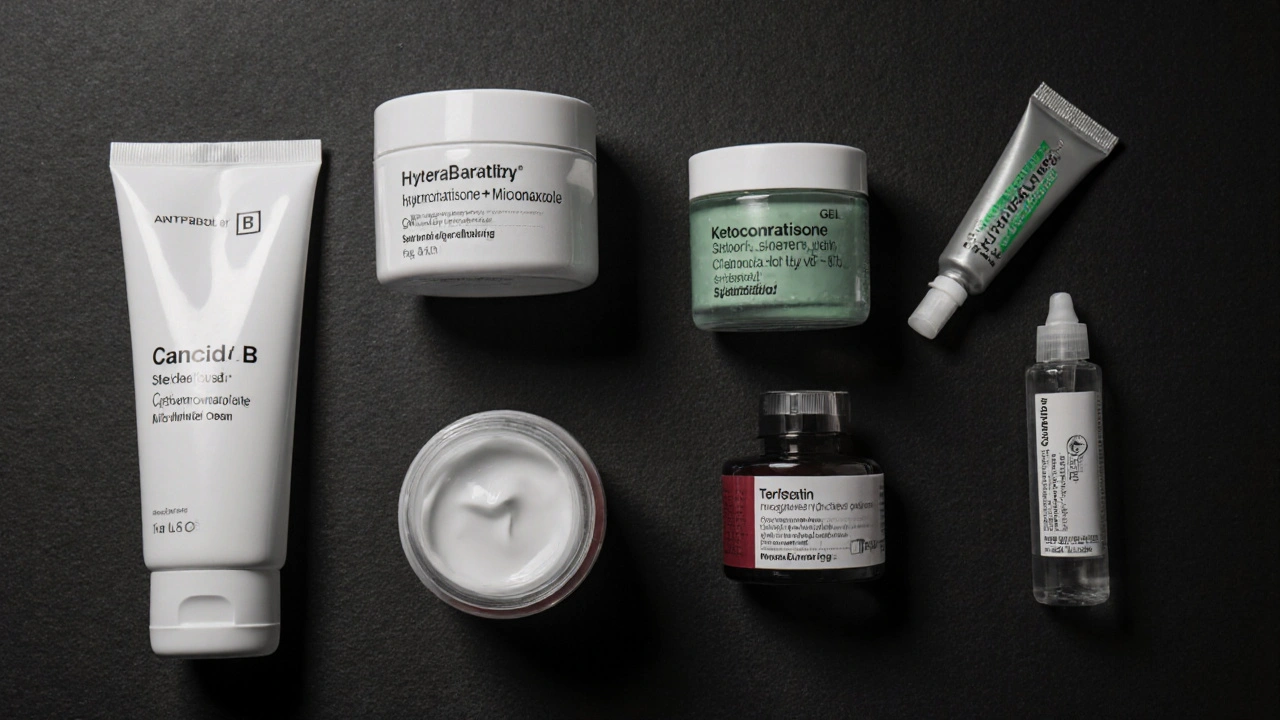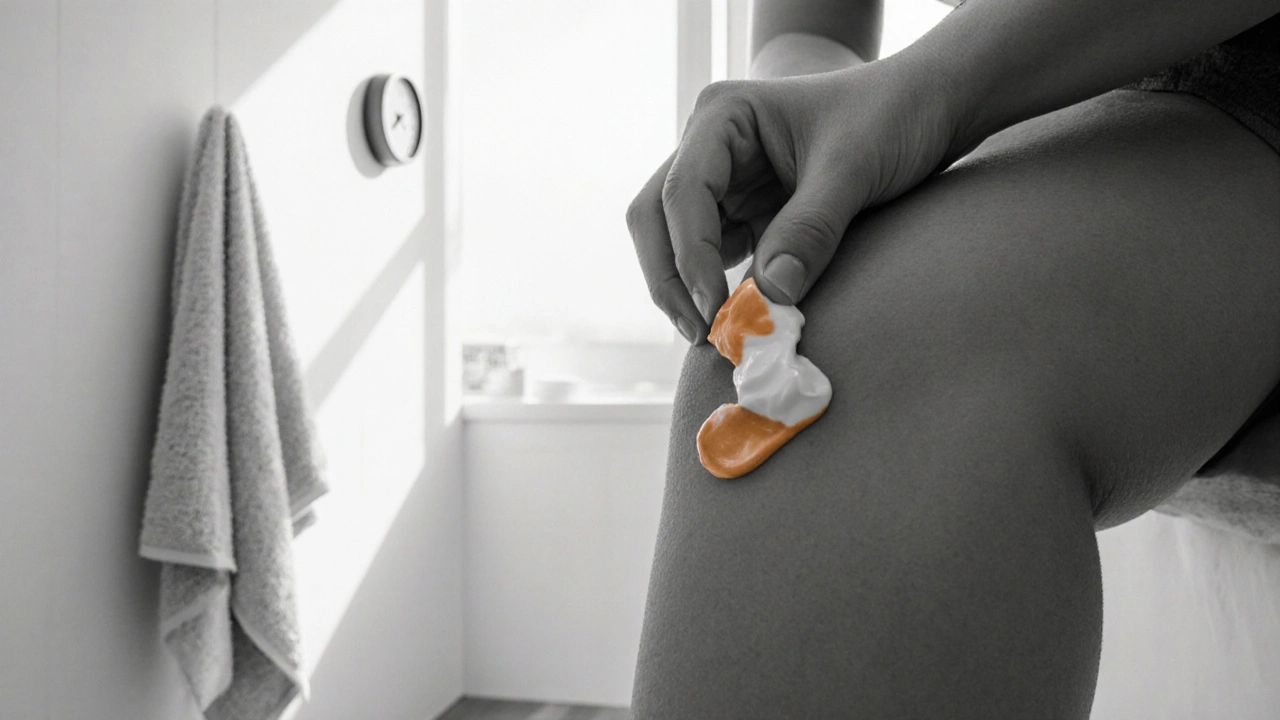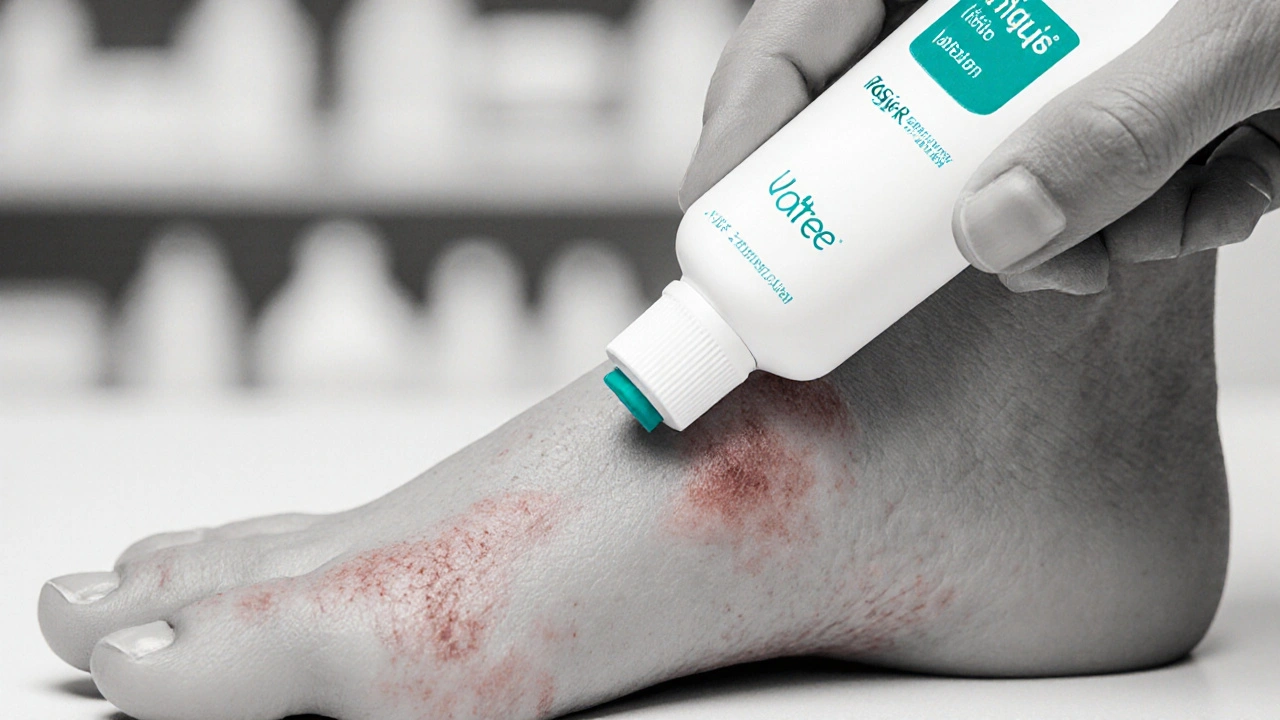When a fungal skin infection flares up, the temptation is to reach for the first cream you see on the pharmacy shelf. But not all topical treatments are created equal, especially when you need both anti‑inflammatory power and antifungal action. This guide breaks down Candid B Lotion - a combination of beclometasone and clotrimazole - and lines it up against the most common alternatives you’ll encounter in UK pharmacies.
What is Candid B Lotion?
Candid B Lotion is a topical preparation that blends a mild corticosteroid (beclometasone) with an antifungal agent (clotrimazole) to treat inflammatory fungal skin conditions. It’s marketed for conditions where a fungal infection is accompanied by redness, swelling or itching - such as athlete’s foot with intense inflammation or a candida rash that’s irritating the skin.
How the Ingredients Work Together
Beclometasone is a synthetic corticosteroid that reduces inflammation by suppressing the local immune response. It calms the skin, eases itching and limits the reddening that often makes fungal infections look worse than they are. Clotrimazole is an azoles antifungal that disrupts the cell membrane of dermatophytes and yeasts, halting their growth. When paired, the steroid clears the inflammatory “noise” while the antifungal attacks the root cause.
Pros of Candid B Lotion
- Dual action tackles both symptoms and infection in one step.
- Beclometasone is a low‑potency steroid, reducing risk of skin thinning compared with stronger steroids.
- Convenient lotion base spreads easily over large, moist areas like intertriginous zones.
- Available on prescription in the UK, ensuring pharmacist guidance.
Cons of Candid B Lotion
- Requires a prescription - over‑the‑counter (OTC) alternatives may be quicker to obtain.
- Potential steroid‑related side effects (skin atrophy, telangiectasia) if used longer than recommended.
- Clotrimazole resistance, although rare, has been reported in stubborn Candida strains.
- Cost can be higher than single‑ingredient creams.

Common Alternatives on the UK Market
Below are the most frequently suggested substitutes, each with its own strength and limitation.
- Hydrocortisone+Miconazole Cream - a low‑potency steroid paired with a broader‑spectrum antifungal.
- Ketoconazole 2% Cream - a potent azole without any steroid component.
- Terbinafine 1% Gel - an allylamine that works especially well on dermatophytes.
- Nystatin Suspension - a polyene antifungal ideal for Candidaalbicans infections, steroid‑free.
- Clotrimazole 1% Cream (OTC) - antifungal only, useful when inflammation is mild.
Side‑by‑Side Comparison
| Product | Active Ingredients | Typical Indications | Prescription? | Average UK Cost (per tube) | Common Side Effects |
|---|---|---|---|---|---|
| Candid B Lotion | Beclometasone 0.025% + Clotrimazole 1% | Inflamed fungal infections (tinea, candida) with itching | Yes | £8‑£12 | Mild skin thinning, burning sensation |
| Hydrocortisone+Miconazole Cream | Hydrocortisone 1% + Miconazole 2% | Dermatophyte infections with moderate inflammation | OTC | £5‑£9 | Rare irritation, steroid‑related atrophy if overused |
| Ketoconazole 2% Cream | Ketoconazole 2% | Broad‑spectrum fungal infections, seborrheic dermatitis | OTC | £4‑£7 | Dryness, mild burning |
| Terbinafine 1% Gel | Terbinafine 1% | Ringworm (tinea corporis), athlete’s foot | OTC | £6‑£10 | Itching, localized redness |
| Nystatin Suspension | Nystatin 100,000IU/mL | Candida diaper rash, oral thrush (topical) | OTC | £3‑£5 | Rare allergic reactions |
| Clotrimazole 1% Cream | Clotrimazole 1% | Simple fungal infections without major inflammation | OTC | £2‑£4 | Mild stinging, dryness |
How to Choose the Right Option
Picking a topical treatment isn’t a one‑size‑fits‑all decision. Consider these criteria:
- Level of inflammation - If redness and swelling dominate, a steroid component (Candid B or Hydrocortisone+Miconazole) can provide faster relief.
- Type of fungus - Dermatophytes respond well to terbinafine, while Candida species are often best tackled with clotrimazole or nystatin.
- Prescription vs. OTC - If you need immediate access, OTC options win. For persistent or widespread cases, a GP prescription for Candid B may be warranted.
- Cost and coverage - NHS prescription charges apply to Candid B, whereas many OTC creams are reimbursed by private insurance.
- Skin sensitivity - Patients with thin skin or a history of steroid‑induced atrophy should avoid steroid‑containing lotions.
In practice, you might start with an OTC antifungal for mild cases. If inflammation spikes, a short course of Candid B (as advised by a pharmacist) can bring symptoms under control without switching products.

Practical Tips for Using Topical Antifungal Steroids
- Apply a thin layer to clean, dry skin; excessive amounts don’t speed up healing.
- Rub in gently and wash hands afterward to avoid spreading the infection.
- Limit use to 2‑3 weeks unless a doctor says otherwise - longer exposure raises side‑effect risk.
- For intertriginous areas (groin, under breasts), keep the region dry for at least an hour after application.
- Monitor for worsening redness, blistering or spreading; seek medical advice if these occur.
Frequently Asked Questions
Frequently Asked Questions
Can I use Candid B Lotion on children?
Yes, but only under a doctor’s supervision. The steroid dose is low, yet children’s skin can be more susceptible to thinning, so a short‑term regimen is advised.
What’s the difference between beclometasone and hydrocortisone?
Beclometasone is a slightly more potent corticosteroid than hydrocortisone, yet both are in the low‑potency class. Beclometasone often offers a smoother texture in lotion form, which some patients prefer for moist areas.
Do I need a prescription for Candid B Lotion in the UK?
Yes. The combination of a steroid with an antifungal classifies it as a prescription‑only medicine (POM) in England, Wales, Scotland and Northern Ireland.
Is it safe to switch from Candid B to an OTC cream after symptoms improve?
Often, yes. Once the inflammation subsides, continuing with an antifungal‑only product (like clotrimazole or terbinafine) can finish the eradication phase without further steroid exposure.
What should I do if I develop a rash while using Candid B?
Stop the lotion immediately and contact a pharmacist or GP. A new rash could signal an allergic reaction, secondary infection, or steroid‑induced irritation that needs professional assessment.
In short, Candid B Lotion fills a niche where inflammation and fungal infection collide. If you’re dealing with a mild rash and want an OTC fix, clotrimazole alone or a hydrocortisone‑miconazole blend might be enough. For stubborn, inflamed cases, the prescription‑only combo of beclometasone and clotrimazole offers a fast, two‑pronged attack. Always weigh the need for steroid power against potential side effects, and don’t hesitate to ask a pharmacist for guidance.


Comments (8)
Annette van Dijk-Leek
October 16, 2025 AT 14:03Wow, this guide really breaks it down for us!! 🎉 If you’re battling a funky rash, having both a steroid and antifungal in one bottle sounds like a dream!!! The low‑potency beclometasone gives you relief without the scary side‑effects of heavyweight steroids, and the clotrimazole attacks the fungus head‑on!!! Plus, it’s a lotion, so it glides on nicely even in those soggy spots!!! Give it a try if you’ve got a prescription handy!!!
Katherine M
October 22, 2025 AT 08:57Esteemed readers, the juxtaposition of pharmacological agents within Candid B Lotion warrants a measured contemplation. One must weigh the merits of dual‑action therapy against the principle of monotherapy, particularly in contexts where inflammation is marginal. Moreover, the socioeconomic dimension-prescription cost versus OTC accessibility-cannot be dismissed. 🌐🧐
Bernard Leach
October 28, 2025 AT 03:50Choosing the right topical agent begins with an honest assessment of the clinical picture. If the rash is red, swollen and itching, the steroid component can provide rapid symptom relief. Beclometasone, despite being low potency, still dampens the local immune response enough to calm the skin. Clotrimazole, on the other hand, interferes with fungal cell membranes and halts replication. The combination therefore attacks both the cause and the effect. However, one must be vigilant about the duration of therapy to avoid steroid‑induced skin thinning. A typical course of two to three weeks is often sufficient for most inflammatory fungal infections. Extending treatment beyond that window should only be done under medical supervision. For patients with a history of steroid sensitivity, alternative non‑steroidal antifungals may be preferable. Over‑the‑counter options such as clotrimazole 1% cream are suitable for mild cases lacking significant inflammation. Hydrocortisone‑miconazole blends provide a similar dual approach but with a different potency profile. Ketoconazole 2% cream offers broad antifungal coverage without any steroid, making it ideal for purely fungal etiologies. Terbinafine gel excels against dermatophytes, especially in athlete’s foot. Nystatin suspension remains the drug of choice for Candida infections in moist intertriginous areas, particularly in infants. Cost considerations also influence decision‑making; prescription‑only products like Candid B may carry a higher price tag. Ultimately, shared decision‑making with a pharmacist or physician ensures the chosen therapy aligns with the patient’s needs and circumstances.
Shelby Larson
November 2, 2025 AT 22:43Honestly, you’re overcomplicating a simple rash.
Mark Eaton
November 8, 2025 AT 17:37Hey folks! If you’re on a budget, try the OTC clotrimazole cream first-just a thin layer and you’ll see improvement. If the redness spikes, then maybe grab a prescription for the combo. Keep the area dry and you’ll be good.
Alfred Benton
November 14, 2025 AT 12:30While the comprehensive analysis presented is commendable, one must question the implicit endorsement of prolonged steroid use; the risks of iatrogenic atrophy, especially in delicate intertriginous zones, are non‑trivial. Moreover, the suggestion to default to a two‑to‑three‑week regimen lacks nuance concerning patient‑specific factors such as comorbidities and prior corticosteroid exposure.
Susan Cobb
November 20, 2025 AT 07:23Indeed, the cautionary tone is warranted, yet the original author appears overly conservative; modern dermatological practice often embraces short bursts of low‑potency steroids without severe sequelae, particularly when guided by precise application protocols.
Ivy Himnika
November 26, 2025 AT 02:17In formal terms, the evidence‑based guidelines suggest that a treatment window of five to seven days is sufficient for most inflammatory fungal conditions, thereby mitigating the concerns raised above. 😊